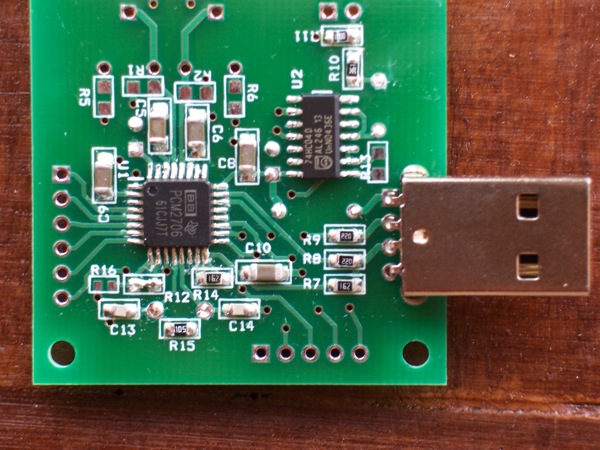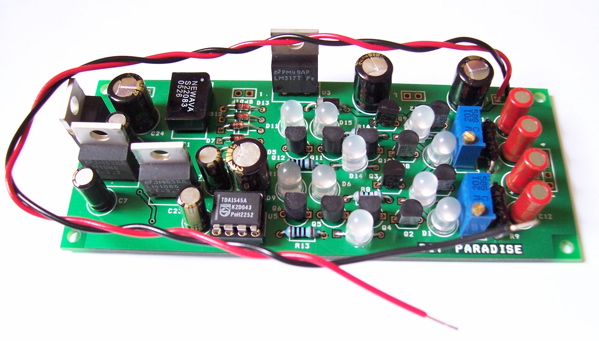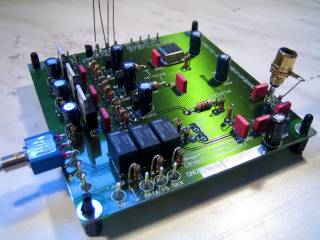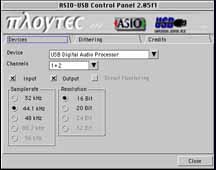Trends Audio has a very nice USB-->S/PDIF out

yes this is more aimed at the music listener and looks promising. DOnt use it as a dac though. There are better dacs outside and they are still developing their own dedicated dac.
http://www.audiomagus.com/index.php?page=shop.product_details&category_id=25&flypage=shop.flypage_modern&product_id=3&option=com_virtuemart&Itemid=27i researched the net a bit and met
 http://www.hagtech.com/hagusb.html
http://www.hagtech.com/hagusb.html but hm taking power from the usb port, is real contaminated power although the unit filters it
But the design is not out for the best Very cheap too and nothing on their site suggests aiming for the best sound. But this device will happily with the help of the PC takes the sound 2 jumps in quality up probably more from an average mainstream Cd player.
My choice for the moment is even more economical than this one, but the concept IS to find the best sound ( within reasonable cost) and has I2S out ( very handy to build the USB converter inside your dedicated DAC and bypass the jitter inducing S/PDIF link) See:
 http://diyparadise.com/usb.html
http://diyparadise.com/usb.htmlMuch much better as an USB dac, but incomparably more expensive comes from Serbia.: "The Model" aiming at state of the art.
now a more afffordable dac based on their top model transparent and musical

these ppl have new products and very friendly prices for DI now
see: http://www.audialonline.com/newsletters/03/Serbia also is the creator of probably the best ribbon tweeter. It leaves Raven and the Chinese Aurum Cantus in the dust.
http://www.raalribbon.com/aboutus.htmA more expensive alternative to the Hagtech is "the model" from Serbia in Europe. Almost a rogue state but a fast developing super high end audio industry is coming up.
 http://www.audialonline.com/model/
http://www.audialonline.com/model/Then there are many under 1000 $ USB dacs especially the NOS dacs are promising.
A very good and with a very high Quality/price Ratio USB dac comes from a young enthusiastic young man who is not yet commercially thinking out of Kuala Lumpur, Malaysia
for the moment this my choice
 http://diyparadise.com/monica3.html
http://diyparadise.com/monica3.htmlthis is not the normal Monica with 0.3V out but Monica + linestage on one pcb and the new III version
AdditionI met this site , and this is a real tweaker using high precision Tent clocks. I use a tent clock in my TEAC transport, so this guy (within reasonable cost) is out for the best, including tips for BG or boutique film caps His kits are very cheap compared to his "perfectionist " approach and the "Rolls Royce"quality of topology and pcb quality

USB to I2S Converter 49€
al his kits the SMD parts are pre-soldered by a professional bureau You only have to assemble and solder the "classique" parts

you know, those "big" caps and resistors. And his musical reference is the openness and body of 3D tube sound
Doede made S'PDIF dacs before he was converted to USB DACS ((1543 based and stackable up until 60 (!) dac chips in a so called tower configuration)
http://www.dddac.de/ddsales-pre-config.htmhis comments about USB "sound":
"
All relatively normal improvement so what about the USB Interface ??? Well, now we are talking a completely different story !!!!! ------------------>
The sound of a bit copied CD sound unbelievable "clean". The soundstage goes much deeper and wider, you can really "look through" the whole sound stage. For example, listening to a choir, I could identify individual line up where with SPDIF this was diffuse..... Dynamics and tonal balance do not change, it is really the extreme transparency of the stereo image.....
This is so good, I already bought a fan less PC, a 8" touch screen and a USB disk drive. This will turn in the coming time into my Music Server !!!! (I will report when it is ready  http://www.dddac.de/
http://www.dddac.de/ is a nice read, for the serious high end listener DIY
A best alternative for "the model" or any above suggestions, is the 1500 US $ "pace car" a well thought out design ( still in last developing phase is my impression) it is a high precision reclocker which accepts S/pdif and reclocks it to a level that the jitter of the source becomes irrelevant:
"The Pace-Car is a very flexible architecture reclocker that can be used with USB, Wireless
audio servers, some PCI cards and even Transports. We like to call it the "Swiss Army
Knife" of reclockers. The Pace-Car reduces the jitter from these streaming audio devices
to inaudible levels." In that case what sounds better SB, Cd transport or PC transport
becomes an obsolete question. They all sound just as good as the main factor for the perceived sounding differences: the jitter is practically out of the equitation. See:
http://www.empiricalaudio.com/frPace-Car.htmlThen it becomes a matter of convenience. However it does not have a USB inut. But any USB S/PDIF converter will do. The trend , the Hagtech or the very expensive converter of empiricalaudio themselves:

It has been designed with very low jitter in mind, so preceding the Pace-Car would be massive overkill
http://www.empiricalaudio.com/frComputer_Audio.html#Off-Ramp%20I2SStill important is to have
a different ASIO driver and NOT the free Asio4all driver as it was not designed for the general public's but for studios and their typical multimachine problems. You want real high end sound from USB for yr single DAC use the usb-audio driver from
www.usb-audio.comFor instance: ""Unlike ASIO2KS and ASIO4ALL, which are wrappers for KS, the usb-audio driver talks directly to the hardware completely bypassing the OS audio stack." XEnithon, and
And from the Hagtech weblog:
"Tried out the
www.usb-audio.com driver for windows. It's the alternative to ASIO4ALL... Wow, best sound I've had yet. Seems to be the real thing. No goofy wrappers and dlls and other wierd stuff. Just a new usbaudio.sys for windows... Now it is guaranteed to bypass kmixer and all that other crap."
"Yep, this is it. Best sound yet. The
www.usb-audio.com driver for xp is the best yet. This is the way it should have been done in the first place. I am
now using latest foobar2000 with this usb_asio driver from Germany. No wierdness, no games, just straight unmodified 16 bit data sent out USB port.
Listening here with a CHIME connected to an OBOE (for headphone output). Best playback yet from CD. Very clean and open." with thx to WGH
The driver to use costs 59 €
 http://www.usb-audio.com/
http://www.usb-audio.com/Readings
a good and easy read is:
http://www.affordableaudio.org/PCAudioBasics.pdf BASIC guide to PC AUDIO
http://diyparadise.com/computer_audio.html99% on the net recommends Foobar for playing lossless cd's, but Winamp has an asio plugin as well
http://www.winamp.com/plugins/download/156466Also Jriver Media Center ,replacing windows MP with good net FB synergises with Asio
http://www.jrmediacenter.com/newinMC12.htmlBuild your own USB Audio Streaming Server for Livingroom use:
http://www.dddac.de/op09.htma very thorough guide but not so easy to read is
how to convert a PC into a music server( from "sics" try to find his better name) :The Art of building Computer Transports
Version 0.3http://photos.imageevent.com/cics/theartofbuildingcomputertransports/The%20art%20of%20building%20Computer%20Transports.pdfhttp://imageevent.com/cics/v03theartofbuildingcomputertrnspuse of EAC and lossless (FLAC) audio format, very visual guide
 http://www.carltonbale.com/project/cd-audio-extraction/
http://www.carltonbale.com/project/cd-audio-extraction/another EAC guide also with nice pictures:
http://wiki.slimdevices.com/index.cgi?EACInstallTIP 1I found if you copy your lossless music files to a memory card, I use a Scandisk 1 gig card, and you play Winamp or Foobar ( of course with ASIO) directly from the memory card instead from the hdd, the sound is even more stable and transparent. I hear subtle echoes and voices within voices i never heard before
 TIP 2
TIP 2from enjoy themusic.com
When converting approximately 750MB of audio data to MP3, file size is reduced to roughly 1/3rd. WAV and EAC are the same as the originals on CD
FLAC is about half. Yet FLAC sounds
way better than WAV and EAC.
It might have something to do with the software I used to play back FLAC. FLAC -- Free Lossless Audio Codec -- is basically encoded WAV in a lossless but compressed file. I used Amadeus II for playback. Even when the Sound Characteristics were set to the original 16-bit/44.1kHz, the FLAC playback outperformed WAV and EAC with decisively more mellowness and finesse. At times, I even might say that it outperformed the original CD playback on the PowerBook.